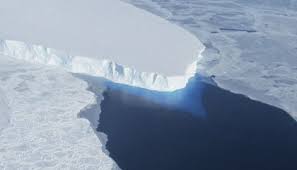A record-breaking heatwave in Antarctica, the coldest and most remote continent on Earth, has caused an unprecedented rise in temperatures in the region, sparking widespread concern among scientists who fear that this event may signal even more drastic climate changes in the future. What is even more alarming is that this temperature increase could have far-reaching consequences, not only affecting the health of the continent itself but also global climate conditions and the lives of millions of people around the world.
Since mid-July 2024, temperatures in Antarctica have risen up to 10°C above average, something completely atypical for a continent that experiences the most extreme weather conditions on Earth. Although much of the region remains below freezing, the impact of such an intense heat event is immeasurable. In some areas of East Antarctica—one of the coldest zones on the planet—temperatures, which typically range from -50°C to -60°C, have reached much higher values, in the range of -25°C to -30°C. This change is nothing short of shocking, considering that East Antarctica, which covers about two-thirds of the continent, is traditionally one of the most protected areas from global warming.

To put this phenomenon into perspective, it’s important to compare what is happening in Antarctica with what is recorded in other parts of the world. In places like Bismarck, North Dakota, for example, temperatures can easily reach -28°C at least once a year, but this is far from the impact that a temperature rise in Antarctica could have, not only on the continent but on global climate balance. A heat event in such a cold region is not just a climatic anomaly, but a potentially irreversible change in Earth’s ecosystem. While most of the continent is still below freezing, this heatwave, although limited in some areas, serves as a warning that something more complex and devastating is unfolding.
Antarctica holds about 70% of the world’s fresh water, meaning any significant alteration in its ice layers could have catastrophic effects on global sea levels. If all of Antarctica’s ice mass were to melt, sea levels would rise by more than 45 meters, resulting in massive destruction of coastal communities worldwide. Additionally, smaller glaciers like the Thwaites Glacier, whose collapse has also been the focus of intense study, could contribute more than 3 meters to sea level rise, which would also be devastating. The risk of this happening is increasing, especially as heatwaves like this one become more frequent and intense.
The concern grows even more when considering that this event is not an isolated incident. The temperature increase in Antarctica during the winter of 2024 is the most recent in a series of heatwaves recorded in recent years. During a previous heatwave in March 2022, temperatures exceeded normal values by up to 21°C, the largest temperature deviations ever recorded in the region. The intensity of these phenomena is directly linked to human-induced climate change, particularly the rise in fossil fuel pollution, which contributes to global temperature increase. According to a study published in 2023 in Geophysical Research Letters, climate change had a direct impact on the intensity of the 2022 heatwave, adding 3.6°C to the observed warming in the region. Scientists warn that by the end of the century, heatwaves could be 11°C to 12°C more intense than they are today, signaling that accelerated ice melt could become an even more catastrophic reality in the coming decades.
Although the 2024 heatwave was not as extreme as that of 2022, it stood out due to its breadth and duration. Ted Scambos, a glaciologist at the University of Colorado, emphasizes that the 2024 event is much broader and longer-lasting, with favorable climatic conditions that caused nearly continuous warming in the region throughout the weeks of August. The key difference between the heatwaves of 2022 and 2024, according to experts, is not just the intensity but the atmospheric conditions responsible for accelerating the warming. The disruption of the Southern Polar Vortex, a rare and highly disruptive phenomenon, was one of the main factors responsible for the current heatwave.
The Southern Polar Vortex is an area of low pressure that forms in the upper atmosphere of Antarctica, where strong winds circle the region, keeping cold air trapped over the continent. This vortex is crucial for the climatic stability of Antarctica because it prevents warm air masses from moving south. However, when the Southern Polar Vortex breaks up, it allows the cold air that was trapped to escape and spread to other areas, while warm air waves enter the region, warming the atmosphere and accelerating ice melt. This phenomenon of Southern Polar Vortex disruption occurs much less frequently than the northern counterpart, which helps explain why heatwaves like these are so rare. However, the frequency of these events may be increasing, reflecting a concerning trend of climatic instability driven by global climate change.
The disruption of the Southern Polar Vortex, though rare, has been responsible for generating intense heatwaves that affect Antarctica, and the 2024 event is a clear manifestation of this increasing instability. The fact that multiple warm air waves from the southwest Indian Ocean have consecutively impacted East Antarctica, almost continuously, has serious implications. East Antarctica, which typically experiences extreme temperatures and is less susceptible to such disturbances, was one of the most affected areas, showing that even the most remote and inhospitable regions of the continent are being impacted by global warming.
The warming of Antarctica is a phenomenon that has been accelerating in recent decades. Studies show that the South Pole has warmed more than three times the global average rate of warming between 1989 and 2018, meaning that climate change is manifesting more intensely on the Antarctic continent. This has led to significant ice mass loss, with Antarctica losing an astonishing 280% more ice in the 2000s and 2010s than in the 1980s and 1990s, according to a 2019 study published in the Proceedings of the National Academy of Sciences. This melting is occurring at an alarming rate and has long-term implications for global sea levels.
Recent research on the Thwaites Glacier, one of the most threatened in West Antarctica, has shown that melting in the region is accelerating faster than previously thought. However, East Antarctica, where the 2024 heatwave occurred, is also becoming an area of great concern. Excessive heat and accelerated ice melt have led to a significant increase in East Antarctica’s contribution to sea level rise.
The consequences of these changes for coastal communities around the world are enormous. Rising sea levels could flood densely populated coastal areas, forcing millions of people to leave their homes and creating massive population displacement. Island nations and lower coastal regions, such as Bangladesh, the Pacific Islands, and major coastal cities around the world, are already facing the impacts of rising sea levels, and projections indicate that this situation will only worsen in the coming years.
In summary, the 2024 heatwave in Antarctica is not just a climatic anomaly. It is a sign of a larger and more lasting change, reflecting the consequences of global climate change. As these events become more frequent, Antarctica, one of the greatest regulators of global climate, may become increasingly vulnerable to melting, with irreversible impacts on sea levels and global climate conditions. Ongoing study of these events is crucial to understanding the magnitude of the problem and the steps that can be taken to mitigate its effects, ensuring that humanity can deal with the consequences of a world warming at an alarming rate.

